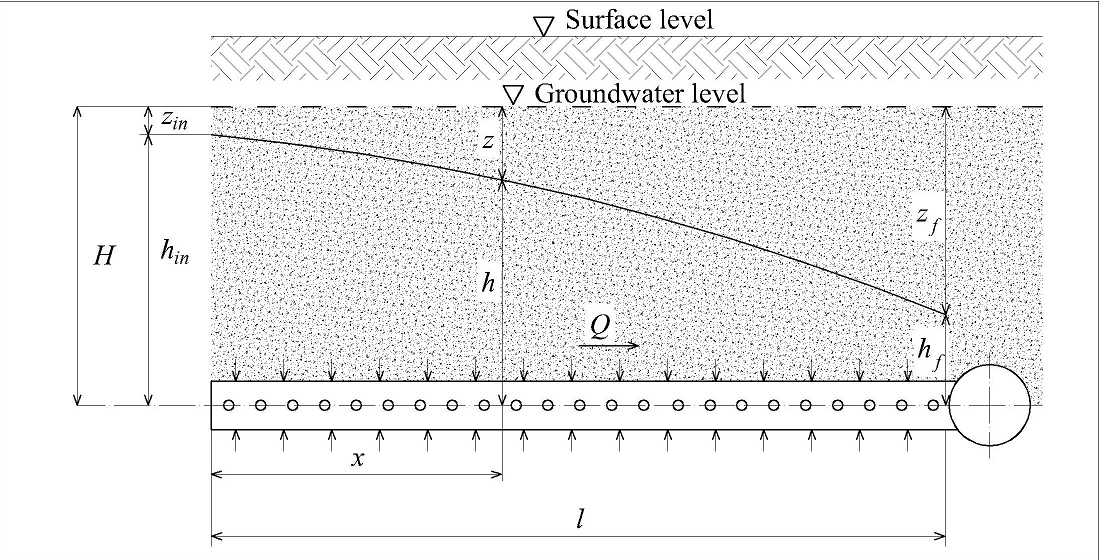Визначення особливостей зміни величини гідравлічного коефіцієнта тертя збірних дренажних трубопроводів
DOI:
https://doi.org/10.15587/1729-4061.2023.292258Ключові слова:
збірний дренажний трубопровід, змінна витрата, фільтраційний опір, гідравлічний коефіцієнт тертяАнотація
Об’єктом дослідження в даній роботі є збірні дренажні перфоровані трубопроводи, зокрема визначення гідравлічного коефіцієнта тертя λдр, який суттєво впливає на параметри досліджуваних труб. З’ясування даного питання дозволить вирішити важливу інженерну задачу – розробити надійну методику гідравлічного розрахунку збірних дренажних перфорованих труб. Адже основним недоліком більшості існуючих теоретичних та експериментальних робіт з даної тематики є недостатнє врахування фільтраційних характеристик навколишнього ґрунту і матеріалу стінок трубопроводу. Проведені експериментальні дослідження напірних дренажних труб з різними конструктивними характеристиками дозволили з’ясувати реальну картину потоку рідини в трубі. За результатами досліджень було отримано експериментальні залежності λдр від величини співвідношення швидкостей втікаючої рідини до середньої швидкості руху потоку у відповідному перерізі (Uo/V), а також від конструктивних характеристик каналу. Визначено максимальну можливу витрату, яку може зібрати і пропустити збірний дренажний трубопровід із заданими конструктивними і фільтраційними характеристиками. Показано, що більшому значенню вказаного співвідношення відповідають більші значення λдр. Даний результат можна пояснити впливом приєднуваної витрати на основний потік. Очевидно, що на взаємодію приєднуваного і основного потоку в трубі витрачається певна енергія, а це призводить до додаткових втрат напору. В роботі отримано залежності для розрахунку досліджуваного коефіцієнта для збірних дренажних трубопроводів. Їх застосування при розрахунку дренажних труб дозволить підвищити надійність і ефективність роботи меліоративних систем, в яких дані трубопроводи є важливими конструктивними елементами
Посилання
- Valipour, M., Krasilnikof, J., Yannopoulos, S., Kumar, R., Deng, J., Roccaro, P. et al. (2020). The Evolution of Agricultural Drainage from the Earliest Times to the Present. Sustainability, 12 (1), 416. doi: https://doi.org/10.3390/su12010416
- Castellano, M. J., Archontoulis, S. V., Helmers, M. J., Poffenbarger, H. J., Six, J. (2019). Sustainable intensification of agricultural drainage. Nature Sustainability, 2 (10), 914–921. doi: https://doi.org/10.1038/s41893-019-0393-0
- Cao, Y., Xu, M., Ni, P., Mei, G. (2021). Physical and numerical modelling of infiltration from drainage holes for perforated storm sewer. Acta Geotechnica, 17 (2), 527–543. doi: https://doi.org/10.1007/s11440-021-01247-0
- Cherniuk, V., Hnativ, R., Kravchuk, O., Orel, V., Bihun, I., Cherniuk, M. (2021). The problem of hydraulic calculation of pressure distribution pipelines. Eastern-European Journal of Enterprise Technologies, 6 (7 (114)), 93–103. doi: https://doi.org/10.15587/1729-4061.2021.246852
- Li, P., Wu, J. (2019). Drinking Water Quality and Public Health. Exposure and Health, 11 (2), 73–79. doi: https://doi.org/10.1007/s12403-019-00299-8
- Kravchuk, O. A. (2021). Particularities of hydraulic calculation of collecting preassure drainage pipelines. Bulletin of Odessa State Academy of Civil Engineering and Architecture, 83, 130–138. doi: https://doi.org/10.31650/2415-377x-2021-83-130-138
- Kravchuk, A., Kochetov, G., Kravchuk, O. (2020). Improving the calculation of collecting perforated pipelines for water treatment structures. Eastern-European Journal of Enterprise Technologies, 6 (10 (108)), 23–28. doi: https://doi.org/10.15587/1729-4061.2020.216366
- Clemo, T. (2006). Flow in Perforated Pipes: A Comparison of Models and Experiments. SPE Production & Operations, 21 (02), 302–311. doi: https://doi.org/10.2118/89036-pa
- Murphy, P., Kaye, N. B., Khan, A. A. (2014). Hydraulic Performance of Aggregate Beds with Perforated Pipe Underdrains Flowing Full. Journal of Irrigation and Drainage Engineering, 140 (8). doi: https://doi.org/10.1061/(asce)ir.1943-4774.0000740
- Kravchuk, A., Cherniuk, V., Kravchuk, O., Airapetian, T. (2022). Assessing the value of the hydraulic friction factor in pipelines working with a flow connection along the path. Eastern-European Journal of Enterprise Technologies, 5 (7 (119)), 61–67. doi: https://doi.org/10.15587/1729-4061.2022.265670
- Liu, H., Zong, Q., Lv, H., Jin, J. (2017). Analytical equation for outflow along the flow in a perforated fluid distribution pipe. PLOS ONE, 12 (10), e0185842. doi: https://doi.org/10.1371/journal.pone.0185842
- Krogstad, P.-A., Kourakine, A. (1999). The Response of a Turbulent Boundary Layer to Injection through a Porous Strip. Proceeding of First Symposium on Turbulence and Shear Flow Phenomena. doi: https://doi.org/10.1615/tsfp1.700
- Qin, Z., Liu, H., Wang, Y. (2017). Empirical and quantitative study of the velocity distribution index of the perforated pipe outflowing along a pipeline. Flow Measurement and Instrumentation, 58, 46–51. doi: https://doi.org/10.1016/j.flowmeasinst.2017.09.010
- Oleinyk, A. Ya., Poliakov, V. L. (1987). Drenazh pereuvlazhnennыkh zemel. Kyiv: Naukova dumka, 279.
- Oyarce, P., Gurovich, L., Duarte, V. (2017). Experimental Evaluation of Agricultural Drains. Journal of Irrigation and Drainage Engineering, 143 (4). doi: https://doi.org/10.1061/(asce)ir.1943-4774.0001134
- Zhang, Q., Wang, Z. (2014). Modeling Study on Fluid Flow in Horizontal Perforated Pipes with Wall Influx. International Journal of Fluid Mechanics Research, 41 (6), 556–566. doi: https://doi.org/10.1615/interjfluidmechres.v41.i6.80
- Kravchuk, A., Kravchuk, O., Lomako, A., Kravchuk, O. (2022). Variation of the collective drainage pipelines parameters when passing the transit flow. Problems of Water Supply, Sewerage and Hydraulic, 41, 52–58. doi: https://doi.org/10.32347/2524-0021.2022.41.52-58

##submission.downloads##
Опубліковано
Як цитувати
Номер
Розділ
Ліцензія
Авторське право (c) 2023 Andriy Kravchuk, Volodymyr Cherniuk, Gennadii Kochetov, Oleksandr Kravchuk, Tamara Airapetian

Ця робота ліцензується відповідно до Creative Commons Attribution 4.0 International License.
Закріплення та умови передачі авторських прав (ідентифікація авторства) здійснюється у Ліцензійному договорі. Зокрема, автори залишають за собою право на авторство свого рукопису та передають журналу право першої публікації цієї роботи на умовах ліцензії Creative Commons CC BY. При цьому вони мають право укладати самостійно додаткові угоди, що стосуються неексклюзивного поширення роботи у тому вигляді, в якому вона була опублікована цим журналом, але за умови збереження посилання на першу публікацію статті в цьому журналі.
Ліцензійний договір – це документ, в якому автор гарантує, що володіє усіма авторськими правами на твір (рукопис, статтю, тощо).
Автори, підписуючи Ліцензійний договір з ПП «ТЕХНОЛОГІЧНИЙ ЦЕНТР», мають усі права на подальше використання свого твору за умови посилання на наше видання, в якому твір опублікований. Відповідно до умов Ліцензійного договору, Видавець ПП «ТЕХНОЛОГІЧНИЙ ЦЕНТР» не забирає ваші авторські права та отримує від авторів дозвіл на використання та розповсюдження публікації через світові наукові ресурси (власні електронні ресурси, наукометричні бази даних, репозитарії, бібліотеки тощо).
За відсутності підписаного Ліцензійного договору або за відсутністю вказаних в цьому договорі ідентифікаторів, що дають змогу ідентифікувати особу автора, редакція не має права працювати з рукописом.
Важливо пам’ятати, що існує і інший тип угоди між авторами та видавцями – коли авторські права передаються від авторів до видавця. В такому разі автори втрачають права власності на свій твір та не можуть його використовувати в будь-який спосіб.










